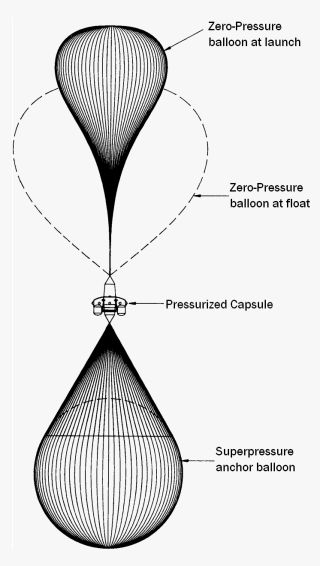Purpose of the flight and payload description
The EARTHWINDS project were a series of manned balloon missions performed along the 90's decade trying to achieve a world circumnavigation using the jet stream winds. The project was created by aeronaut Larry Newman whom was accompanied by different crews on each mission. The balloon system used in the project was based in the Sky Anchor concept originally developed at Texas A&M University in middle 70's for the balloon program of the NASA which was researching a long duration flight system. It used a helium filled zero-pressure balloon for lift and an air filled superpressure balloon for ballast.
DESCRIPTION OF THE SYSTEM
The zero-pressure main balloon with a volume of 1.2 million cubic feet was constructed with three layers of 2.0 mil Astrofilm E2. The balloon accessories included a large helium valve, ribbed wedge and collar base fitting, internal inflation tube and interface for the replenishment system. The balloon was attached to the capsule through a single point termination fitting. The superpressure anchor balloon with a volume of 0.5 million cubic feet was fabricated with a Spectra 904 outer shell and a three layer 0.8 mil Astrofilm E2 internal bladder. The anchor was suspended by a load skirt attached with a single point termination to a harness below the capsule. Both a venting valve and pressurization blower were attached via the top fitting to control the mass of air within the anchor.
The capsule for the crew was suspended from the zero-pressure balloon with the anchor balloon hanging below. A cryogenic helium replenishment system was used to increase altitude control and extend duration. It consisted of two dewars with a capacity of 750 pounds of liquid helium each. Each dewar operated independently, but shared a common ambient air heat exchanger. When evaporated, the helium from both dewars provided lift equivalent to over 10,000 pounds of ballast. The dewars and their ambient air heat exchangers were attached to the outside of the capsule.
OPERATION
With a sky anchor system, the zero-pressure balloon is filled with sufficient helium to lift itself, the payload, and a slightly pressurized anchor. When the air filled anchor balloon is at ambient pressure the enclosed air neither adds nor subtracts from the system mass. As the pressure in the anchor increases the difference in density between the enclosed and ambient air becomes effective ballast.
An equilibrium altitude is reached when the superpressure in the anchor is sufficient to balance the lift of the zero-pressure balloon. This altitude tends to be higher during the day when the helium in the zero-pressure is superheated and provides additional lift. For stable flight some superpressure must remain in the anchor at night. A characteristic of sky anchors is that the amount of superpressure required to provide stable flight is essentially independent of altitude. Changing the mass of air in the anchor, rather than changing the pressure, results only in a different equilibrium altitude. Venting air from the anchor will cause the system to climb, while pumping more air into the anchor will result in a descent. To reduce the superpressure helium must be vented from the zero-pressure balloon to reduce the amount of free-lift. Likewise, increasing the free-lift will result in a proportional increase in superpressure. Free-lift can be increased by dropping conventional ballast or in the case of Earthwinds by adding helium from the cryogenic storage. The system will then rise or descends to a new equilibrium altitude where the superpressure in the anchor again balances the free-lift.The system consisted of two balloons, an upper lifting balloon about 200 feet high filled with 1.1 million cubic feet of helium, and a 100-foot-diameter anchor balloon filled with compressed air suspended beneath the pressurized crew capsule. By pumping additional air into the anchor balloon the crew made it heavier, preventing the balloon from rising high enough to necessitate the release of helium. By releasing air from the anchor the balloon was lightened. This feature allowed the balloon to avoid the need of using conventional sand ballast, which would be exhausted after a few days.
Launch of the balloon and footage of the crash site
Details of the balloon flight
Balloon launched on: 12/31/1994
Launch site: Reno Stead Airfield, Nevada, US
Balloon manufacturer/size/composition: Zero Pressure Balloon Anchor Balloon - 31 150 m3 He / 15 575 m3 air.
End of flight (L for landing time, W for last contact, otherwise termination time): 12/31/1994
Landing site: Anchor balloon failure. Capsule landed in Fallon, Nevada, US
This was the last attempt made by EARTHWINDS at the circumnavigation in the early 1990s. The mission crew was: pilot Larry Newman, along with aeronauts David Melton, and George Saad. The balloon was launched 9:45 EST from Reno, Nevada and was planned to fly over Nevada, Arizona, Texas, Louisiana and the mid-Atlantic states, then head toward North Africa and Asia in a journey expected to take two to three weeks. However, four hours after launched the balloon was on the ground after it popped its ballast balloon. After this failled attempt, the main sponsor Hilton would pull its funding from Larry Newman's project in 1995.
External references
- Earthwinds balloon grounded mid-flight UPI website
- Earthwinds Balloon Takes Off But Is Back on Ground in Hours The New York Times 12/31/1994
- Meteorological Support to the Earthwinds Transglobal Balloon Project Bull. Amer. Meteor. Soc., 76, 477-487
10354If you consider this website interesting or useful, you can help me to keep it up and running with a small donation to cover the operational costs. Just the equivalent of the price of a cup of coffee helps a lot.


